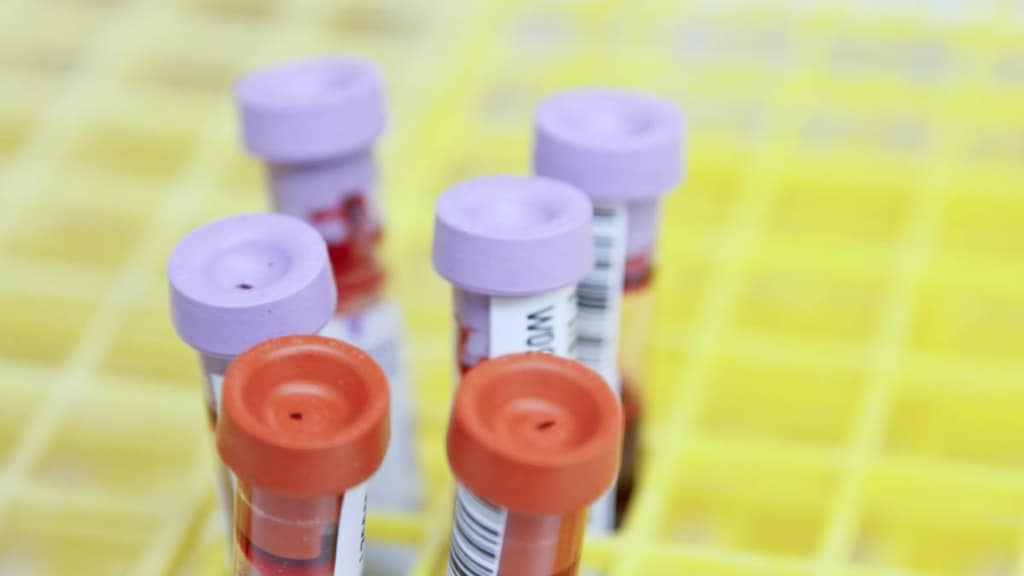Dosage Forms
Excipient information presented when available (limited, particularly for generics); consult specific product labeling.
Kit, Subcutaneous:
Betaseron: 0.3 mg [contains albumin human]
Kit, Subcutaneous [preservative free]:
Extavia: 0.3 mg [contains albumin human]
Pharmacology
Mechanism of Action
Interferon beta-1b differs from naturally occurring human protein by a single amino acid substitution and the lack of carbohydrate side chains; mechanism in the treatment of MS is unknown; however, immunomodulatory effects attributed to interferon beta-1b include enhancement of suppressor T cell activity, reduction of proinflammatory cytokines, down-regulation of antigen presentation, and reduced trafficking of lymphocytes into the central nervous system. Improves MRI lesions, decreases relapse rate, and disease severity in patients with secondary progressive MS.
Pharmacokinetics/Pharmacodynamics
Time to Peak
1-8 hours
Half-Life Elimination
8 minutes to 4.3 hours
Use: Labeled Indications
Multiple sclerosis, relapsing: Treatment of relapsing forms of multiple sclerosis, including clinically isolated syndrome, relapsing-remitting disease, and active secondary progressive disease in adults.
Contraindications
History of hypersensitivity to natural or recombinant interferon beta, albumin (human), or any component of the formulation.
Documentation of allergenic cross-reactivity for interferons is limited. However, because of similarities in chemical structure and/or pharmacologic actions, the possibility of cross-sensitivity cannot be ruled out with certainty.
Canadian labeling: Additional contraindication (not in US labeling): Pregnancy, decompensated liver disease (Betaseron, Extavia); current severe depression and/or suicidal ideation (Extavia)
Dosage and Administration
Dosing: Adult
Note: Analgesics and/or antipyretics may help decrease flu-like symptoms on treatment days.
Multiple sclerosis, relapsing: SubQ: Initial: 0.0625 mg (2 million units [0.25 mL]) every other day; gradually increase dose by 0.0625 mg every 2 weeks to a target dose of 0.25 mg (8 million units [1 mL]) every other day.
Dosing: Geriatric
Refer to adult dosing.
Reconstitution
To reconstitute solution, inject 1.2 mL of diluent (provided); gently swirl to dissolve, do not shake. Reconstituted solution provides 0.25 mg/mL. Use product within 3 hours of reconstitution. Discard unused portion of vial. Foaming may occur if swirled or shaken too vigorously; allow vial to sit until foam settles.
Administration
For SubQ administration. The first injection should be administered under the supervision of a health care professional. Withdraw dose of reconstituted solution from the vial into a sterile syringe fitted with needle provided in manufacturer packaging (refer to manufacturer labeling for appropriate size) and inject the solution subcutaneously. The Betaconnect autoinjector may be used with prepared Betaseron syringes after health care provider selects proper depth setting and injection technique (see prescribing information for more detailed use of autoinjector). Sites for self-injection include outer surface of the arms, abdomen (except 2-inch area around the navel), buttocks, and thighs. If patient is very thin, only use the thigh or outer surface of arms. Rotate SubQ injection site. Do not inject into area where skin is bruised, infected, or broken. Patient should be well hydrated. If a dose is missed, administer as soon as remembered; do not administer on 2 consecutive days. Time subsequent doses every 48 hours.
Storage
Store intact vials at 20°C to 25°C (68°F to 77°F); excursions permitted to 15°C to 30°C (59°F to 86°F) for ≤3 months. If not used immediately following reconstitution, refrigerate solution at 2°C to 8°C (35°F to 46°F) and use within 3 hours; do not freeze or shake solution. Discard unused portion of vial.
Drug Interactions
Cladribine: May enhance the adverse/toxic effect of Interferons (Beta). Specifically, the risk for lymphopenia may be increased. Avoid combination
Zidovudine: Interferons may enhance the adverse/toxic effect of Zidovudine. Interferons may decrease the metabolism of Zidovudine. Monitor therapy
Adverse Reactions
>10%:
Cardiovascular: Peripheral edema (12% to 15%), chest pain (9% to 11%)
Central nervous system: Headache (50% to 57%), pain (42% to 51%), hypertonia (40% to 50%), myasthenia (46%), chills (21% to 25%), dizziness (24%), insomnia (21% to 24%), ataxia (17% to 21%)
Dermatologic: Skin rash (21% to 24%), dermatological disease (10% to 12%)
Gastrointestinal: Nausea (27%), constipation (20%), diarrhea (19%), abdominal pain (16% to 19%), dyspepsia (14%)
Genitourinary: Urinary urgency (11% to 13%), uterine hemorrhage (9% to 11%)
Hematologic & oncologic: Lymphocytopenia (86% to 88%), leukopenia (13% to 18%), neutropenia (13% to 14%)
Immunologic: Antibody development (≤45%; neutralizing; significance not known)
Local: Injection site reaction (78% to 85%; including inflammation [53%], pain [18%], tissue necrosis [4% to 5%], hypersensitivity reaction [4%], swelling [2% to 3%], residual mass [2%])
Neuromuscular & skeletal: Weakness (53% to 61%), arthralgia (31%), myalgia (23% to 27%)
Respiratory: Flu-like symptoms (decreases over treatment course; 57% to 60%)
Miscellaneous: Fever (31% to 36%)
1% to 10%:
Cardiovascular: Vasodilation (8%), hypertension (6% to 7%), peripheral vascular disease (6%), palpitations (4%), tachycardia (4%)
Central nervous system: Anxiety (10%), malaise (6% to 8%), nervousness (7%)
Dermatologic: Diaphoresis (8%), alopecia (4%)
Endocrine & metabolic: Hypermenorrhea (8%), dysmenorrhea (7%), weight gain (7%)
Genitourinary: Impotence (8% to 9%), cystitis (8%), urinary frequency (7%), pelvic pain (6%), prostatic disease (3%)
Hematologic & oncologic: Lymphadenopathy (6% to 8%)
Hepatic: Increased serum ALT (>5 x baseline: 10% to 12%), increased serum AST (>5 x baseline: 3% to 4%)
Hypersensitivity: Hypersensitivity (3%)
Neuromuscular & skeletal: Leg cramps (4%)
Respiratory: Dyspnea (6% to 7%)
<1%, postmarketing, and/or case reports: Anaphylactoid reaction, anaphylaxis, anemia, anorexia, apnea, asthma, ataxia, autoimmune hepatitis, blindness, bronchospasm, capillary leak syndrome (in patients with preexisting monoclonal gammopathy), cardiac arrhythmia, cardiomegaly, cardiomyopathy, cerebral hemorrhage, cholecystitis, coma, confusion, convulsion, deep vein thrombosis, delirium, depersonalization, depression, diabetes mellitus, diabetes insipidus, emotional lability, erythema nodosum, esophagitis, ethanol sensitization, exfoliative dermatitis, gastrointestinal hemorrhage, hallucinations, hematemesis, hemolytic-uremic syndrome, hepatic failure, hepatic injury, hepatitis, hepatomegaly, hepatotoxicity (idiosyncratic) (Chalasani 2014), hypercalcemia, hyperglycemia, hyperthyroidism, hyperuricemia, hypocalcemia, hypoglycemia, hypothermia, hypothyroidism, increased gamma-glutamyl transferase, increased serum bilirubin, increased serum triglycerides, lupus erythematosus, maculopapular rash, manic behavior, myocardial infarction, nephrolithiasis, pancreatitis, paresthesia, pericardial effusion, pneumonia, pruritus, psoriasis, psychosis, pulmonary embolism, pulmonary hypertension (Govern 2015; Health Canada Nov. 2, 2016), renal disease (nephritic syndrome), sepsis, shock, skin discoloration, skin photosensitivity, suicidal ideation, syncope, SIADH, thrombocytopenia, thrombotic thrombocytopenic purpura, thyroid dysfunction, tongue edema, tremor, urinary tract infection, urosepsis, urticaria, vaginal hemorrhage, vasculitis, vesiculobullous dermatitis, vomiting, weight loss
Warnings/Precautions
Concerns related to adverse effects:
- Anaphylaxis/hypersensitivity reactions: Allergic reactions (eg, bronchospasm, dyspnea, skin rash, tongue edema, urticaria), including anaphylaxis (rare), have been reported with use; discontinue use if anaphylaxis occurs.
- Drug-induced lupus erythematosus: Cases of drug-induced lupus erythematosus have been reported with some interferon beta products; signs and symptoms include nephritis, polyarthritis, rash, Raynaud phenomenon, and serositis. Positive serologic testing, including positive anti-nuclear and/or anti-double-stranded DNA antibody testing, may occur; discontinue treatment if signs and symptoms of drug-induced lupus erythematosus develop.
- Flu-like symptoms: Associated with a high incidence of flu-like adverse effects; use of analgesics and/or antipyretics on treatment days may be helpful. Improvement in symptoms occurs over time.
- Hepatotoxicity: Has been reported with beta interferons, including rare reports of hepatitis (autoimmune) and hepatic failure requiring transplant; use with caution in patients with concurrent exposure to other hepatotoxic drugs. Monitor liver function tests as clinically necessary. Consider discontinuation if serum transaminase levels increase significantly or are associated with clinical symptoms (eg, jaundice).
- Injection site reactions: Severe injection site reactions (necrosis) may occur which may or may not heal with continued therapy; reactions generally arise within the first 4 months of therapy, but have occurred ≥1 year after initiation. Incidence of reactions tend to improve over time. Patient and/or caregiver competency in injection technique should be confirmed and periodically re-evaluated. Do not inject into affected area until completely healed; if multiple lesions occur, discontinue use until they are fully healed.
- Leukopenia: Leukopenia has been observed; routine monitoring of complete blood counts with differentials is recommended. Dose reduction may be required.
- Neuropsychiatric disorders: Interferons have been associated with severe psychiatric adverse events (psychosis, mania, depression, suicidal behavior/ideation) in patients with and without previous psychiatric symptoms. Avoid use in severe psychiatric disorders and use caution in patients with a history of depression; patients exhibiting symptoms of depression should be closely monitored and discontinuation of therapy should be considered.
- Thrombotic microangiopathy: Cases of thrombotic microangiopathy manifesting as thrombotic thrombocytopenic purpura (TTP) or hemolytic uremic syndrome (HUS) (some fatal) have been reported with interferon beta products. Some cases may occur after several years of therapy. Monitor for new onset hypertension, thrombocytopenia, or impaired renal function; discontinuation of therapy and prompt treatment may be necessary if TTP/HUS are confirmed.
Disease-related concerns:
- Bone marrow suppression: Use with caution in patients with bone marrow suppression; may require increased monitoring.
- Cardiovascular disease: Use with caution in patients with preexisting cardiovascular disease. Rare cases of new-onset cardiomyopathy and/or HF have been reported. If HF worsens in the absence of another etiology, consider discontinuation of therapy. In a scientific statement from the American Heart Association, interferon has been determined to be an agent that may either cause reversible direct myocardial toxicity or exacerbate underlying myocardial dysfunction (magnitude: moderate/major) (AHA [Page 2016]).
- Hepatic impairment: Use with caution in patients with hepatic impairment or in combination with alcohol.
- Seizure disorder: Use with caution in patients with a history of seizure disorder.
- Thyroid dysfunction: Thyroid abnormalities may develop with use; may worsen pre-existing thyroid conditions. Monitor thyroid function tests every 6 months or as clinically necessary.
Dosage form specific issues:
- Albumin: Contains albumin, which may carry a remote risk of transmitting Creutzfeldt-Jakob or other viral diseases.
- Latex: Some dosage forms may contain natural rubber latex.
Monitoring Parameters
Complete blood chemistries (including platelet count) and liver function tests are recommended at 1, 3, and 6 months following initiation of therapy and periodically thereafter. Thyroid function should be assessed every 6 months in patients with history of thyroid dysfunction or as clinically necessary. Monitor for flu-like symptoms, allergic or anaphylactic reactions, injection-site reactions, worsening of cardiac symptoms (in HF patients); and for sign/symptoms of depression.
Pregnancy
Pregnancy Considerations
Data from available pregnancy registries have not observed an increased risk or pattern of major birth defects, preterm birth, or decreased birth weight following maternal use of interferon beta-1b (Coyle 2014; Romero 2015; Thiel 2016). In most cases, therapy was stopped during the first trimester after pregnancy was detected (Thiel 2016).
In general, disease-modifying therapies for multiple sclerosis (MS) are stopped prior to a planned pregnancy, and not initiated during pregnancy, except in females at high risk of MS activity (AAN [Rae-Grant 2018]). When disease-modifying therapy is needed in females planning a pregnancy (eg, high risk of disease reactivation), interferon beta-1b may be considered until pregnancy is confirmed, and in select cases (eg, women with active disease), use may be continued during pregnancy. Delaying pregnancy is recommended for females with persistent high disease activity (ECTRIMS/EAN [Montalban 2018]).
Patient Education
What is this drug used for?
- It is used to treat MS (multiple sclerosis).
Frequently reported side effects of this drug
- Flu-like symptoms
- Abdominal pain
- Trouble sleeping
- Muscle pain
- Tense muscles
- Passing a lot of urine
- Loss of strength and energy
- Injection site irritation
Other side effects of this drug: Talk with your doctor right away if you have any of these signs of:
- Infection
- Thrombotic thrombocytopenic purpura/hemolytic uremic syndrome like bruising or bleeding; severe loss of strength and energy; dark urine or yellow skin; pale skin; change in the amount of urine passed; vision changes; change in strength on one side is greater than the other, difficulty speaking or thinking, change in balance; or fever)
- Capillary leak syndrome like abnormal heartbeat; chest pain; shortness of breath; weight gain; vomiting blood or vomit that looks like coffee grounds; black, tarry, or bloody stools; unable to pass urine or change in amount of urine passed; blood in the urine
- Depression like thoughts of suicide, anxiety, agitation, irritability, panic attacks, mood changes, behavioral changes, or confusion
- Liver problems like dark urine, fatigue, lack of appetite, nausea, abdominal pain, light-colored stools, vomiting, or yellow skin
- Lupus like rash on the cheeks or other body parts, sunburn easy, muscle or joint pain, chest pain or shortness of breath, or swelling in the arms or legs
- Heart problems like cough or shortness of breath that is new or worse, swelling of the ankles or legs, abnormal heartbeat, weight gain of more than five pounds in 24 hours, dizziness, or passing out
- Swelling
- Change in balance
- Seizures
- Swollen glands
- Shortness of breath
- Chest pain
- Bruising
- Bleeding
- Sexual dysfunction
- Abnormal vaginal bleeding
- Severe headache
- Severe dizziness
- Passing out
- Vision changes
- Injection site skin breakdown, discoloration, swelling, or drainage of fluid
- Signs of a significant reaction like wheezing; chest tightness; fever; itching; bad cough; blue skin color; seizures; or swelling of face, lips, tongue, or throat.
Note: This is not a comprehensive list of all side effects. Talk to your doctor if you have questions.
Consumer Information Use and Disclaimer: This information should not be used to decide whether or not to take this medicine or any other medicine. Only the healthcare provider has the knowledge and training to decide which medicines are right for a specific patient. This information does not endorse any medicine as safe, effective, or approved for treating any patient or health condition. This is only a brief summary of general information about this medicine. It does NOT include all information about the possible uses, directions, warnings, precautions, interactions, adverse effects, or risks that may apply to this medicine. This information is not specific medical advice and does not replace information you receive from the healthcare provider. You must talk with the healthcare provider for complete information about the risks and benefits of using this medicine.




